Interplanetary species
From Halopedia, the Halo wiki
| This article is based on canon information, but the article's title is conjectural and/or uses descriptions as the title, as there is currently no official name for the subject. |

As space-faring sentient species began colonizing star systems throughout the Milky Way, many planets were discovered with thriving populations of identical or near-identical plant and animal species, some recognizable from the colonists' respective homeworlds. In many cases, this was a result of the Forerunner Conservation Measure and manipulation by the Lifeworker Rate. In other cases, the cause was not as clear.
On planets where native species were not identical, they largely tended to follow standard morphological baselines to those observed on Earth. Fish looked like fish, insects looked like insects. Amphibians, reptiles, avians, and mammals could all largely be grouped into the same class as their Earth counterparts, even if local environmental pressures caused them to evolve along alternative biological paths. For example, the Jiralhanae homeworld Doisac had a species of cattle which were used by the Jiralhanae similarly to Earth cattle,[1] and the Kig-Yar homeworld Eayn had species of hawks and vultures.[2] Some of the more exotic life forms could also be found distributed across multiple worlds.
Invasive ecology[edit]
- "Atmospheric processors could nudge a generally suitable planet toward sustainability, but they couldn’t remake worlds."
- — Halo: Contact Harvest[3]
In the process of terraforming worlds, humanity employed various methods to nudge local environments towards Earth-normal and sustain a growing population of colonists. Many of these involved the introduction of human agriculture and livestock, as well as forms of wild plant and animal life to balance ecosystems and atmospheric levels for human habitability.[4][5] Some species were also likely introduced by accident after they stowed away aboard ships.
The following is a list of known Earth species that made their way onto alien planets through human action.
Flora[edit]
|
Fauna[edit]
|
Earth-like ecology[edit]
On other worlds, Earth-native species (or species which appeared visually identical) were discovered prior to modern human interference.[6] On many planets, it was common to find terrestrial grasses, ferns, lichen, and algae. On others, more notable species were observed, sometimes dwelling alongside exotic, alien flora, other times part of ecosystems nearly identical to those of Earth.[7][8]
The following is a list of known Earth species that exist on alien planets not as a result of modern human action.
Flora[edit]
|
Fauna[edit]
|
Exotic ecology[edit]
- "There were these big damn plants, like tentacles. I swear, it was like the planet was fighting us, too."
- — Lieutenant Caitlin de Sauveterre[9]
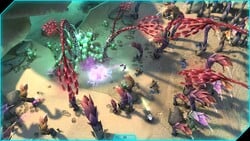
Some forms of life were distinct from those found in Earth ecosystems, despite sharing (in most cases) morphological similarities. A number of these exotic organisms had similar ubiquity across multiple star systems. In some cases, life forms were discovered which resembled prehistoric fauna from Earth's Pleistocene epoch, and some may have actually been transplanted as a result of the Forerunner Conservation Measure, continuing to evolve long after they went extinct on Earth.[10][11] Some exotic species, while first discovered on alien worlds, were transplanted to other planets as a result of interstellar trade.[12]
The following is a list of known exotic species that existed on multiple planets and installations.
Flora[edit]
| Plant | Name | Description | Locations found |
|---|---|---|---|
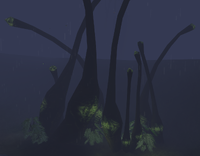
|
Swamp tree | A large bioluminescent plant found around Flood containment facilities on Halo rings[13][14] and on the Covenant Holy City, High Charity.[15] | Alpha Halo, Delta Halo, High Charity |
Fauna[edit]
| Animal | Name | Description | Locations found |
|---|---|---|---|
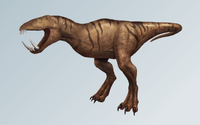
|
Blind wolf | Predatory pack hunters found on various Forerunner installations that primarily rely on sound to direct their attacks.[16][17][18] | The Ark, unidentified Halo ring |

|
Brontothere | Originally found in east Africa in 97,445 BCE.[11] Following their indexing by the Forerunners, brontotheres in the modern era can be found in a variety of biomes on Forerunners installations.[19][18] | Prehistoric Earth, unidentified Halo ring |
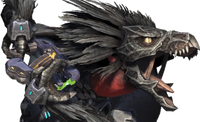
|
Kig-Yar parasites | The Kig-Yar occasionally suffered parasitism from feather mites, tapeworms, and fleas, which were common nuisances across their colonies.[20][21] | Kig-Yar colonies |

|
"Nightmare eel" | A large sea creature found in the Eridanus and Bhaakto systems in deep oceans where it hunts seafloor-dwelling organisms alongside the Paelosur.[22] | Beta Gabriel, Alluvion |
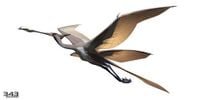
|
Quadwing | A pterosaur-like creature with dual sets of wings that is ubiquitous across many Forerunner installations.[23][24] | The Ark, Delta Halo, unidentified Halo ring |
| Merse | Territorial aquatic creatures that resembled giant lily pads, they were placed on many worlds by Forerunner Lifeshapers, particularly the Librarian. | Bastion, prehistoric Earth, Nomdagro | |
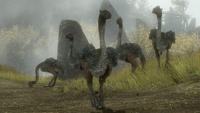
|
Moa | Large, flightless birds named after and resembling the extinct moa of Earth. They were domesticated by humans for use as pets and cuisine, and as a result are found on several other worlds.[12] They are close to extinction on their native homeworld of Reach after the ecological catastrophe caused by the Fall of Reach.[25] | Casbah,[12], Earth,[12] Gannick 22,[25] Reach |
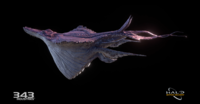
|
Olfmeri | Airborne cetacean-like creatures that can be found on many Forerunner installations, known for their enigmatic grace and beauty.[23] | The Ark, unidentified Halo ring |

|
Paelosur | A sightless cetacean found in the oceans of multiple worlds across the Inner and Outer Colonies, alongside the Qothal.[22] | Beta Gabriel, Alluvion |
| Pheru | Originating from Faun Hakkor, these friendly creatures were domesticated by ancient humans and Forerunners and spread across many of their worlds as pets, ultimately becoming a vector for the first Flood infection in the Milky Way.[26] | Faun Hakkor, Forerunner ecumene | |
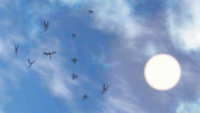
|
"Space bird" | A flying species found on multiple human and Forerunner worlds.[27] | Erebus VII, Eudemon, Requiem, Partition, Talitsa, Terceira |
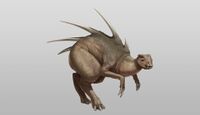
|
Thorn beast | A docile herd herbivore used for food and other resources by the Covenant and the Jiralhanae in particular.[28] | Doisac, Covenant worlds |
Production notes[edit]
- The oxyaena was a creature fully modelled and textured for inclusion in Halo Wars.[29] The Oxyaena was a prehistoric Earth mammal that lived during the Eocene.
- Halo: Reach featured a number of cut lifeforms which resemble highly speciated Earth organisms.
Sources[edit]
- ^ Halo: Empty Throne, chapter 32
- ^ Halo: Mortal Dictata, chapter 6
- ^ Halo: Contact Harvest, chapter 1
- ^ Halo: Contact Harvest, chapter 15
- ^ Halo: Ghosts of Onyx, chapter 10
- ^ Halo: The Fall of Reach, chapter 4
- ^ Halo 4: Forward Unto Dawn
- ^ Halo: Nightfall
- ^ Halo: Spartan Assault
- ^ Halo: Silentium, String 2
- ^ Jump up to: a b Halo: Silentium, String 37
- ^ Jump up to: a b c d Twitter, Halo (@Halo): "Indigenous to the planet Reach, Moas are large flightless birds with feathered bodies and a swift gait. They are widely exported as pets and for food to other human worlds like Casbah and Earth. #FictionFriday" (Retrieved on Sep 6, 2019) [archive]
- ^ Halo: Combat Evolved, campaign level 343 Guilty Spark
- ^ Halo 2, multiplayer map Backwash
- ^ Halo 2, campaign level Gravemind
- ^ Halo: Hunters in the Dark, chapter 9
- ^ Halo: Hunters in the Dark, chapter 12
- ^ Jump up to: a b Halo: Outpost Discovery, The Ring Experience
- ^ Halo Encyclopedia (2022 edition), page 362
- ^ Halo: Mortal Dictata, chapter 6
- ^ Halo: Mortal Dictata, chapter 7
- ^ Jump up to: a b Halo Waypoint: Canon Fodder - Fauna Getaway
- ^ Jump up to: a b Halo Waypoint, Cannon Fodder - Jurassic Ark (Retrieved on Dec 13, 2019) [archive]
- ^ Halo Waypoint, Canon Fodder - Outpost Discoveries (Retrieved on Nov 5, 2019) [archive]
- ^ Jump up to: a b Halo Waypoint, Canon Fodder - Have S'Moa (Retrieved on Jan 16, 2021) [local archive] [external archive]
- ^ Halo: Cryptum, Halo: Cryptum
- ^ Halo 4 Editing Kit, game file
tags\levels\multi\ca_blood_cavern\fx\ca_bird_02a.bitmap - ^ Halo Encyclopedia (2022 edition), page 363
- ^ Gamespot, Halo Wars E3 2008 Stage Show Demo (Retrieved on Jun 1, 2020) [archive]


